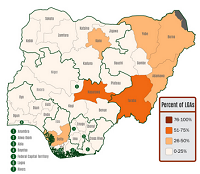Discussing Data: Visualizing Nigerian Pre-Election Trends

In the lead up to the March 2015 Nigerian elections, NDI partner, the Transition Monitoring Group (TMG), deployed a team of over 750 pre-election observers across each of the country’s local government areas (LGAs). These observers have spent the past few months collecting and submitting short message service (SMS) reports on various indicators of interest. This incoming data can be a lot to digest, so to help make some initial sense of it all, the team has turned to data visualization as a component of their analysis. Here to help explain the pre-election observation (PREO) process and its data visualization component is Ryan Dalton, Senior Program Assistant on NDI’s Nigeria team in D.C.
Q: Could you briefly explain the pre-election observation efforts in Nigeria?
A: The PREO process is guided by the principle that access to timely and reliable information about the status of electoral preparations and to early warning signs of the outbreak of electoral violence could help mitigate or reduce the spread or escalation of violence. Such information would allow Nigerian citizens and local communities, security agents, the Independent National Electoral Commission, international and domestic non-governmental organizations, and others to take preventative measures and to adapt electoral preparations and activities to a rapidly changing environment. Our PREO efforts in Nigeria are focused on reports of trained observers placed in each of the country’s 774 LGAs. These local observers send in bi-weekly reports via coded text messages, using a version of NDItech’s Elections DemTool system, on questions relating to the process leading up to the election as well as potential indicators related to election violence, fraud, and irregularities. These observer responses are collected in an effort to better understand the overall social and political pre-election climate of preparedness leading up to E-day (which is now set for March 28, 2015).
This citizen observation is unique in personnel recruitment strategy and data collection methodology. TMG’s nonpartisan citizen observers are recruited from within the communities that they observe. Because of their familiarity with the local context and situational awareness, these observers are well-positioned to gather data to help other electoral actors mitigate and respond to instances of electoral violence. Furthermore, because the observers use the same checklist of questions for each regularly scheduled report, their responses can be aggregated and tracked over time. While the PREO is not sample-based like the parallel vote tabulation methodology, TMG is currently the only organization in Nigeria with a trained observer in every LGA and is the only citizen observer group collecting structured data on the pre-election environment.
Q: Once the data is collected, what’s next?
A: As I mentioned, the pre-election observers submit their checklist responses via coded text message. In essence, this involves sending a series of text messages to a phone number that feeds the responses to the Elections database. These coded messages are then processed by the system, where they are made available for export into spreadsheet form. Thereafter, designated TMG personnel spend an afternoon cleaning the data through call-backs to observers who failed to submit reports or submitted an incomplete report. Next, the data is fed into Google Sheets, where charts and graphs of the relevant questions are created. These graphs and charts are embedded into a drupal-based open data repository called DKAN, which facilitates the cataloging, publishing, and visualization of all PREO data. The aforementioned graphs and charts join DKAN maps (also based upon the coded SMS data), which are broken down at the Zone, State, and LGA level, as part of the overall data visualization presentation. While the data is not visualized instantaneously, the turn-around time on a dataset of over 150,000 datapoints takes no more than about five hours once the data is cleaned --- so it is quite rapid!
Q: Is it important/helpful to visualize the incoming data quickly?
A: Rapid generation of visuals for the incoming data is important as it allows NDI and TMG to better understand what state-to-state, regional and national trends are and what the pre-election environment stories are from reporting period to period. This allows TMG to produce PREO reports that are timely, comprehensive and identify key pre-election issues. While this observation is not sample-based, it currently provides the most systematic and rapid pre-election environment assessment in Nigeria. These initial visualizations, particularly the time-series graphs for each of the 40 questions on our PREO checklist, help our team gain a good sense of the data, allowing us to pick out notable trends that deserve further investigation. Because we can identify these trends quickly, our team can better focus our efforts on the questions and data points of greatest interest.
Q: What about for external presentation? Is any of the data analysis and visualization presented publicly?
A: After the data in DKAN is analyzed, our efforts shift to preparing pre-election reports with more complex visuals, infographics and narrative text for public consumption. These reports are essentially distilled, digestible versions of the relevant trends and information gleaned from the observer SMS reports and the initial data visualizations. These reports are shared with the media and general public on our partner TMG’s website and social media accounts as well as via email to a broad range of election stakeholders.
Q: If you were to outline another pre-election observation process - either for Nigeria or perhaps somewhere else - what suggestions would you make? Would you include data visualization as a core element?
A: The goals of another country program’s pre-election observation should guide the decision whether or not to have data visualization as a core component. If issuing timely reports to relevant election stakeholders in order to respond to pre-election environment issues and mitigate conflict is one of those goals, data visualization could be very beneficial. For the Nigeria program, it has aided with rapid data analysis, identifying trends and drafting reports.
